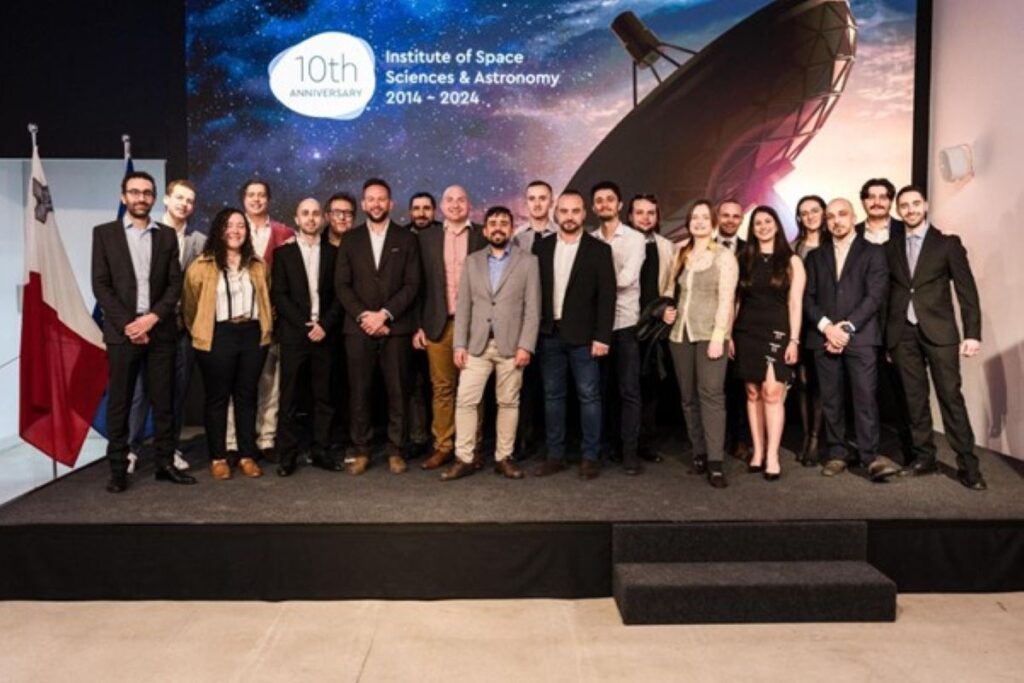Founded by Prof. Kristian Zarb Adami, a leading figure in Maltese Space Sciences, the University of Malta’s Institute of Space Sciences and Astronomy (ISSA) has flourished as an organisation at the intersection of fields crucial to our understanding of the universe.
The institute, which recently celebrated its tenth anniversary, views collaboration as its bedrock. The institute works on flagship projects with institutions and space agencies from across the globe. Many readers will be familiar with eye-catching achievements such as European Space Agency missions and the James Webb telescope. Soon, many will also become familiar with the Square Kilometre Array, which is capturing radio images of the universe’s infancy and, in many respects, represents the field’s future.
ISSA has produced over a dozen PhD graduates and benefits from a broad swathe of affiliate and support staff. However, the easiest way of examining its multidisciplinarity is through its key members. Its director, Prof. Alessio Magro, along with Dr Andrea De Marco and Prof. Jackson Levi Said, each pursue distinct yet interconnected areas of astronomy.
The Sound of Space – Prof. Alessio Magro
As Magro explains, ‘Currently, ISSA has three main research areas. I’ll let Jackson and Andrea discuss theirs, but my focus is what’s called “instrumentation”.’
Instrumentation refers to the development of devices vital to astronomy – the telescopes, satellite dishes, and antennae required to study the stars. More specifically, my focus is on radio astronomy, including the search for “fast radio bursts” – bursts of extremely high energy originating outside the Milky Way. Nobody knows what causes them.’ Another main focus of Magro’s research involves detecting “21 centimetre emissions” – radio wavelengths emitted by hydrogen atoms, some of which may have originated only a few hundred million years after the Big Bang. The radio wavelengths produced by hydrogen can be used to map its distribution from eons ago, and through it, the structure of the early universe.
Magro’s field is concerned with maximising the information we can glean from the stars. But all that information must be processed and analysed. ‘This is a computationally expensive procedure, so we must create systems that can keep up.’
The Place for Artificial Intelligence – Dr Andrea De Marco
The sheer scale and breadth of astronomical data are making machine learning an increasingly important tool. This leads us to one of De Marco’s specialities: AI and machine learning. As De Marco describes, shortly after the ISSA’s inception in 2014, ‘there was already an interest in the application of AI and machine learning to astronomical data. ISSA was working with other institutions in designing the Square Kilometre Array.’ This is an enormous radio telescope being built in South Africa and Australia – a product of equally enormous international collaboration. ‘In its early days, this raised the question of how we would ingest but also process and utilise this data – and whether this process could be automated in an intelligent way using deep learning.’
‘The idea is to detect radio sources – remnants of supernovas, or traces of uninvestigated radio galaxies. Individually, these tasks are not too difficult for an astronomer. But there is so much data coming in all the time that it would take an army of astronomers to stay on top of it.’ AI is ideally suited to perform what De Marco describes as a “first pass” of this analysis – a methodology that could eventually be applied beyond his current focus on radio astronomy, including in the analysis of optical data.
Questioning the Universe – Prof. Jackson Said
In overly simplified terms, the instruments Magro develops observe our universe, both from beyond our galaxy and from billions of years in the past. The immense volume of data they generate is then processed using De Marco’s AI techniques. This brings us to Said’s work: comparing and interpreting the results.
Said explains, ‘As Magro was saying, he is working on huge telescopes that are observing data from the very, very early universe. Our data analysis team applies that data to the standard cosmological model – our current understanding of the Big Bang and the universe’s subsequent evolution to the present day. One thing our research group does is suggest new cosmological models that tackle open questions arising from these observations, and questions arising from relevant theory.’
These questions cut to the core of who we are. Said continues, ‘One of the first questions we asked as a species was, “What are the dots in the sky?” And now we’re asking, “Where did the universe begin?” These investigations are always something we have cared deeply about. We have always been ready to invest time and effort into them as a society. Now we have the technological tools – the instruments developed by academics like Magro; the data analysis tools that De Marco specialises in; and the analytical models investigated in my field. These unlock the capacity to really understand what happened after the Big Bang, in the epoch of reionisation that followed the universe’s dark ages, and beyond.’
ISSA stands at the intersection of three pillars of modern astronomy that are bringing us tantalisingly close to understanding our origins. It bridges past and present, near and far, and the global human effort to know our universe.
The following abridged article by Jonathan Firbank features in Issue 47: Disciplines of THINK Magazine, the official research magazine of the University of Malta. For more articles from the edition, pick up a copy on Campus or read here. (Republished courtesy of THINK).
